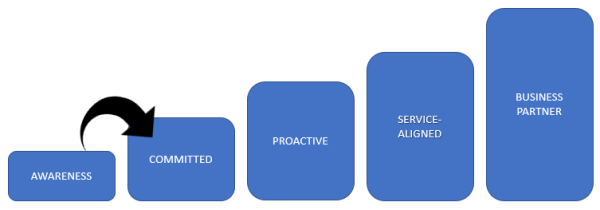
In this post, we look at the typical attributes of a “Level 1” organization (Awareness), and what IT Infrastructure and Operations (I&O) leaders can do to make the transition to the next level of IT maturity (Committed).
There are a number of available IT maturity models, including:
- The Capability Maturity Model (CMM) for software development
- The CMMI (Capability Maturity Model for Integration),
- Gartner’s ITScore for Infrastructure and Operations,
- Axelos’s ITIL Maturity Model. All of these use a 5-level structure.
These all use a 5 Level structure.
The five levels of maturity stack up progressive layers of capabilities. Each layer is foundational for the layers above, with many dependencies—meaning there are no short cuts. It takes time to embed the new processes, skills, behaviors, tools and relationships that underpin IT capabilities. Progression from one level to another can typically takes at least a year of effort (Source: Gartner Inc.).

What “Level 1” (Awareness) looks like
Level 1— initial, chaotic, or reactive (depending on which model you’re most familiar with)—is defined by a lack of visibility, documentation and organization. Activity is predominantly reactive, with IT people constantly scrambling to keep IT systems up-and-running. With so much of IT’s time and resources dedicated to “keeping the lights on”, there is little time to pursue development projects that advance the business. The combination of regular service disruption and lack of capacity to support new, technology-driven business objectives means the external perception of IT is very low.
With no formal processes in place, and no visibility of the infrastructure, technicians are essentially stumbling around in the dark. The ability to find and fix issues quickly is largely reliant on the knowledge, experience and effort of individual “IT heroes”. IT people are generally well aware of the key issues, but are too engaged in firefighting to make any real progress towards a stable, reliable infrastructure.
With everybody in IT in firefighting mode, there is little structure to the organization. Technical domain experts like database admins, network experts and even developers may be called in to solve, for example, basic desktop support issues. The lack of documented processes causes conflict between teams, which in turn causes more service disruptions. Likewise, with no knowledge capture or collaboration in place, IT people frequently waste time reinventing the wheel.
The underlying infrastructure is a stratified mix of new and legacy technologies, based on mixed architectures that are fragile and difficult to integrate. With data locked in siloes, the organization finds it difficult to collate and analyse data to support better business decisions.
What to do next
1. Processes
Leverage IT Infrastructure Library (ITIL) best practices to get incident management under control, and assess service desk tools for flexibility—so that you can adapt these processes to fit with changing business demands. Apply a rudimentary change process to eliminate conflicts and prevent snowballing service disruptions.
2. People
Examine where the skills and experience lie—who are the domain experts with the most valuable capabilities? Examine where skills shortages may be hurting IT support and preventing consolidation and improvement of the underlying infrastructure. Familiarize staff with best practices like ITIL and COBIT so that everybody has a shared understanding of processes and terminology. Encourage communication between teams to unearth (and leverage) valuable tribal knowledge.
3. Technology
Evaluate the business relevance of IT systems, retiring redundant systems and supporting infrastructure. Consolidate remaining infrastructure to simplify support and reduce total cost of ownership (TCO). Implement standard builds for desktops to shorten the process of finding and fixing errors.
4. Management
Establish a multi-tiered service desk structure with the front-line acting as a single point of contact for service and support issues across the business—and supported behind the scenes by specialist teams focusing on desktops, databases, applications, servers and other technologies. Identify and examine the issues that are most frequently impacting the business. Prioritize actions to resolve the most disruptive issues. Establish a Change Advisory Board (CAB) to evaluate change priorities and risks—ensuring changes do not create more issues than they solve.
Buying IT management technology
At this stage, organizations are beginning to look at tools to help them get a grasp on the growing complexity of their IT estate. Home-grown IT management solutions are not a viable option: purchase or rent the technology you need to log issues, manage process flows and gain visibility of the infrastructure. When sourcing IT management tools, organizations should consider integration with their existing systems monitoring/management ecosystem.
In our next article in the series we’ll look at Level 2 IT maturity (Committed) organizations and how they can make the step up to level 3 (Proactive).
Find out More
WHITEPAPER: Why you need to consider your IT maturity when choosing IT management technology